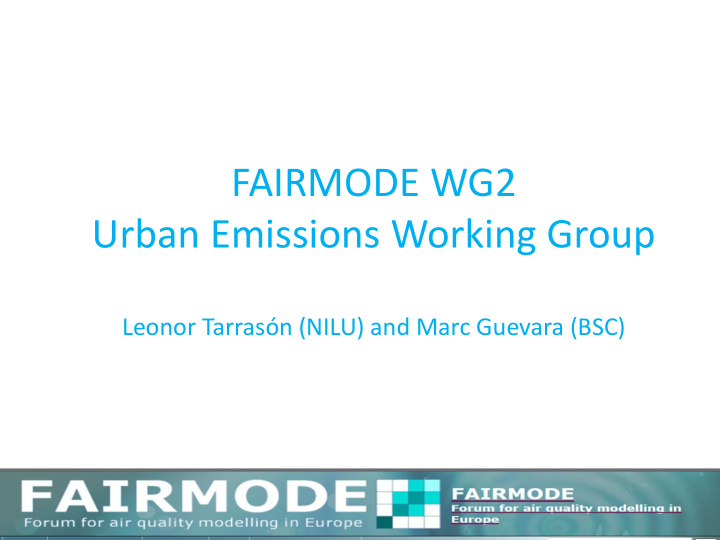



FAIRMODE WG2 Urban Emissions Working Group Leonor Tarrasón (NILU) and Marc Guevara (BSC)
WG2: Best practices for urban traffic emissions Adapted from Ejik (2012) and Bedogni (2014) Brower (2014) Automatic Number Plate Floating Car Data Recognition systems Traffic models and wireless Extended Floating Car Data traffic sensors 2 https://envirocar.org/
FAIRMODE Emission Benchmarking Emission Delta Tool: contributes to close the gap between urban bottom-up emission estimates and top-down estimates Oslo, Bergen, Stavanger - Norway Stockholm - Sweden Havana- Cuba The country UK – UK Madrid – Spain Porto and Lisbon - Portugal
Sensor capabilities for «bottom-up» urban emission development
Sensor capabilities for «bottom-up» urban emission development WG2 proposal Smart City Emissions
Sensor capabilities for «bottom-up» urban emission development
Sensor capabilities for «bottom-up» urban emission development Tom Tom, OBS GPS information on • Road segment • Average time travel • Average speed (+ standard deviation, percentiles) • Time variation (year, month, week, day, hours) Aggregated information from speed derives - fuel consumption - Driving patterns – congestion - CO2 emissions - Noise Vehicle technology is not available – Taxi fleet in Oslo
On-going NILU projects contributing to this emission work ECLECTIC – for healthier air Big Data Services
On-going NILU projects innovating emission compilation work ECLECTIC – for healthier air ”SMART AIR INLET” ECLECTIC combines model and sensor data to provide a smart control of the air intake in the car coupe • reduce air intake when airo utside is of poor quality • increases the air ventilation when the quality of the air outside is good
On-going NILU projects innovating emission compilation work ECLECTIC – for healthier air ”GREEN ZONES” • Automatic recognition of green zones • Green zones can be defined close to hospitals, schools ... • As hybrid cars turn on electric drive • As fossil fuel cars activate their eco-drive mode (ref VW dieselgate)
Urban Labs – the air quality where you are CITI-SENSE Raise awareness and increase public participation on air pollution issues using new sensor technologies Citi-Sense-MOB Combine new sensor technology, information and communication platforms and participatory methods to create personalized services CrowdAir Collaboration project with Norwegian University to create a mobile app to report perception on air pollution and health.
On-going NILU projects innovating emission compilation work iResponse Social Responsible Crowdsourcing on Water, Air and Urban Planning Source www.caps2020.eu ICT – enable participatory urban water design and management Wood consumption/emissions from house heating Urban Planning through public participation
Contribution to FAIRMODE ”THE FAIRMODE KNOWLEDGE WHEEL” WG Data Fusion ? WG4 Planning WG1 Modelling Best practices Benchmarking Intercomparisons WG3 Source WG2 Urban Allocation Emissions
Relevance of emission improvements • WG1: Understand emission Evaluation of effect of short term measures in Oslo driven differences in Composite maps • WG3: Facilitate evaluation of source contributions • WG4: Evaluation of urban scale measures – contribution to smart city planning • CC1: Improve forecasting of AQ • CC2: Support to evaluation of station representaiveness • CC3: Ancilliary information for data fusion activities
Discussion Questionnaire on best practices on-going Evaluation of top down vs bottom up inventories – on going at regional scale Evaluation of top down vs bottom up inventories – on going at urban scale The Δ -emission tool does not include have spatial information • Would it be useful with a new inter-comparison study – A Composite Map for Emissions? • Do we need to introduce a new WG on data fusion?
Recommend
More recommend